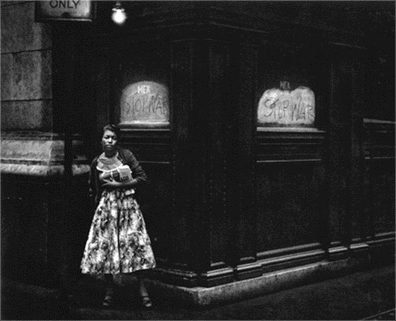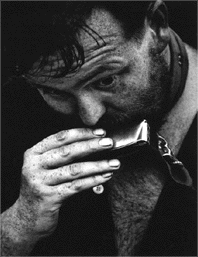 |
Lumiere
Press, 2000
If it were a time of day, it would be twilight; a season, fall.
If it were a text it would be Nicolas Gogol's Tales of Good
and Evil or Rainer Maria Rilke's Malte Laurid Brigges's Notebooks.
If it were a day, it would be overcast, with a hint of rain
and an unexpected ray of sun piercing through the clouds. If
it were music, it would be the shrill notes of a street harmonica
or an accordion. But it is a book by Dave Heath, A Dialogue
With Solitude, published in 1965 and long out of print. It is
Heath's only book and clearly one that has its place as a classic
along with Robert Frank's Lines of My Hand, Larry Clark's Tulsa
and Gene Smith's essay on Pittsburgh.
This new edition has been enlarged in format to that of the
photographer's original design. As with Roy de Carava's Sweet
Flypaper of Life it is a mixed blessing, losing in intimacy
and immediacy what it gained in size and perfection of printing.
Heath is a photographer's photographer. His book has an emotional
obliqueness and reserve of sorts that leaves a strong impression,
yet the feelings it evokes are hard to put into words. The photographs
are mostly dark, with a light, brittle and fugitive, briefly
glowing in parts of the pictures like a small fire on a piece
of charcoal, about to be extinguished. Shadows and reflections
are endowed with as much substance as flesh.
|
 |
|
 |
The book is built like a piece of music, a jazz riff maybe with
long silences in between parts, and six stanzas that could be
titled solitude, contemplation, love, war, revolt, beginnings.
But the book does not have a beginning and an end. It revolves
upon itself and the blanks in between sequences are as important
as silences in music. The subtle sequencing that varies sizes,
formats and placement on the page plays off the secret geometry
that ties lights and shadows within each image and creates visual
links from page to page.
Brambles of thorns touched by light, a small pool of water,
reflections of spired towers in a river, a crumbling brick wall
with crosses. Then humans--lost in sleep, reading, embrace,
waiting. Angry black faces, a demonstration. A body under a
blanket. The rotten body of a dog, a round of spent cartridges.
A soldier in the morning fog. A midget in front of the Louvre's
monumental granite Egyptian kneeling sculptures of the Ancient
Kingdom, lost in contemplation. These are some of the poignant
images that Heath weaves together.
Though he touches on subjects such as the Korean war (in which
he fought) and racial and social injustice, Heath cannot be
called a documentarian. His images blend the personal and the
political but they never demonstrate. As he explains in his
preface, Heath does not want his concern for the world to turn
into anger and bitterness, but into an expression of hope for
the human condition. Even when the images are bleak, there is
always the sense of expectancy and possibility. This is what
makes us turn the pages time and again.
Carole Naggar |

A Dialogue With Solitude is available through the Howard Greenberg
Gallery
which recently organized a show by Dave Heath and represents his work.

|
|


